Ellis Island Immigrant Hospital
| Ellis Island | |
|---|---|
_hospital.jpg) Ellis Island Immigrant Hospital | |
| Location |
Ellis Island Jersey City, New Jersey |
| Coordinates | 40°41′58.4″N 74°2′22.5″W / 40.699556°N 74.039583°WCoordinates: 40°41′58.4″N 74°2′22.5″W / 40.699556°N 74.039583°W |
| Elevation | 7 ft (2.1 m)[1] |
| Built | 1902 |
| Architectural style(s) | Georgian Revival[2] |
| Governing body | National Park Service |
| Website | http://www.nps.gov/elis/ |
| Official name: Statue of Liberty National Monument, Ellis Island and Liberty Island | |
| Designated | October 15, 1966[3] |
| Reference no. | 66000058 |
| Official name: Statue of Liberty National Monument | |
| Designated | added October 15, 1965[4] |
 Location in Port of New York and New Jersey  Ellis Island Immigrant Hospital (New Jersey)  Ellis Island Immigrant Hospital (the US) | |
The Ellis Island Immigrant Hospital, also known as USPHS Hospital #43, was the United States’ first public health hospital, opened in 1902 and operating as a hospital until 1930. Constructed in phases, the facility encompassed both a general hospital and a separate pavilion style contagious disease hospital. The hospital served as a detention facility for new immigrants who were deemed unfit to enter the United States after their arrival; immigrants would either be released from the hospital to go on to a new life in America or sent back to their home countries. The hospital was one of the largest public health hospitals in United States history and is still viewed today as an extraordinary endeavor in the public health field.[5]
The hospital is part of the Statue of Liberty National Monument. While the monument is managed by the National Park Service as part of the National Parks of New York Harbor office, the south side of Ellis Island has been off-limits to the general public since its closing. Efforts to restore the hospital buildings and others on the island are being made by government partner Save Ellis Island. In October 2014, the hospital opened to the public for small-group hard hat tours.[6]
History

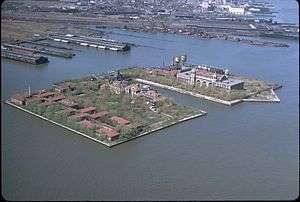
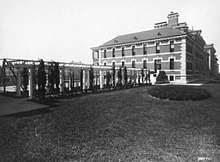
The original immigration station on Ellis Island opened January 1, 1892, and processed 700 people that first day. In September of that year, the Hamburg-America steamer S.S. Moravia[7] arrived at quarantine with several confirmed cases of cholera. Every ship arriving in the port of New York was held at quarantine before being cleared to land. Passengers found to have dangerous contagious diseases were taken off ships at quarantine and transferred to the hospital at either Hoffman or Swinburne Island. Twenty-four of Moravia's passengers were ill and twenty-two deaths had occurred during the voyage. Many were children. It was believed that the outbreak occurred due to the ship taking on contaminated water from the Elbe river. The threat of a pandemic caused all shipping traffic to be suspended. The backlog of ships held at quarantine and the lack of adequate medical facilities to handle the volume quickly precipitated the need for a more robust healthcare facility to treat immigrants and merchant marine sailors.
On June 15, 1897, the wooden immigration station on Ellis Island was destroyed by fire. Plans were immediately made to build a new, fireproof immigration station on Ellis Island. The Supervising Architect of the Treasury, James Knox Taylor had just been recently appointed, and was charged with undertaking the design of the new Immigration Station and all of the ancillary buildings. Utilizing the provisions of the Tarsney Act, Taylor decided to solicit designs from private architects via design competition. The winning entry was awarded to the architects William Alciphron Boring and Edward Lippincott Tilton, and included the Main Building, Power House #1, a Kitchen & Laundry building, General Hospital, and Surgeon's House. The island itself was to be increased in size utilizing landfill, with the hospital being located across a new ferry basin from the Main Building on its own island. This was in response to the prevailing germ theory that germs could not travel across a body of water.
With the completion of the Main Building in 1900 and the new hospital in 1901, the volume of immigrants was quickly overwhelming the facility's capacity. Plans were soon undertaken by James Knox Taylor to add a new Administration building, completed in 1907 and an additional hospital wing completed in 1909 to effectively double the number of wards. However more cases were arriving with contagious diseases, and plans were drawn up by Taylor and his staff as early as 1906 to construct a new Contagious Disease Hospital. Despite this, funding had not been appropriated by congress for the construction. Successive appropriations did not provide enough money to build the entire facility, and so a phased approach was implemented. The buildings sat vacant for two years until funding for the heating and electrical equipment was provided. As such the Contagious Disease Hospital was not completed or operational until 1911.
Ultimately over twelve million immigrants were processed through the new Ellis Island Immigration Center during its years of operation. Every immigrant had to go through a thirty-second health inspection upon arrival. Only third class or steerage passengers were inspected at Ellis Island, as first and second class passengers were inspected onboard ship by medical officers at quarantine. Tens of thousands of immigrants, or one out of every five, were pulled out of line for further evaluation and screening. Half were for legal reasons, and the other half received a chalk mark on their clothing, signaling a health deficiency. These immigrants were often sent on to the Ellis Island Immigrant Hospital to be detained until they recovered or were deemed too sick to enter the United States, in which case they would be sent back to their home countries. Sometimes an entire family's status could depend on the outcome of one family member's illness. In some cases, it meant that the entire family had to return home or be separated. However, nine out of ten patients who entered the hospital were eventually cured and allowed to enter the United States. The care was not free. The first few weeks of care were paid for by the steamship companies, who were responsible for the welfare of their passengers until they were cleared to land. Part of their charge was to screen immigrants before they boarded ship at the port of departure. Thus if an immigrant was not cleared to land and was "excluded" at Ellis Island, they were deported at the steamship company's expense. Immigrants could post a bond at their own expense, or petition to receive treatment for extended illnesses. Only 1% of the 12 million immigrants who arrived at Ellis Island were deported due to medical reasons.
The Immigrant Hospital was initially staffed by the Marine Hospital Service, which became the U.S. Public Health Service. It was one of the first facilities in the country to employ a full-time female physician, Dr. Rose A. Bebb. Physicians treated an incredible range of disease, from measles, tuberculosis, trachoma, scarlet fever, Favus, and diphtheria, to tropical diseases imported from the opposite side of the earth. The hospital was considered to be one of the most extensive public health systems in the world, using advanced methods in medicine that had just been introduced, such as fluoroscopy and an autoclave that could sterilize entire mattresses. For many immigrants, new medical equipment was unfamiliar and scary. According to one New York Times article, “those less fortunate had to submit to physical inspections that required stripping off all of one’s clothing – an entirely foreign concept, particularly to many immigrant women. Some immigrants had no idea what X-ray machines did; others were fearful that their clothing – or the money sewn inside its seams – would be stolen.”[8]
By 1914, the hospital was fully operational; in that year, over 10,000 patients from 75 different countries were treated. In all years of operation, from 1902 to the 1930s, over 3,500 immigrants died at the Immigrant Hospital. Roughly half were children. However, 350 babies were also born on the island, and were often named after the nurses and doctors that helped deliver them. These included children of staff who worked on the island.
Now discredited, eugenic beliefs played a small role at the hospital. Dr. Henry H. Goddard established an intelligence testing program on Ellis Island during 1913. Doctors would use metal calipers to measure the circumference of immigrants’ heads, and immigrants of “superior racial stock” were often favored when entering the United States.[9] Additionally, many immigrants were detained at Ellis Island for mental illness and placed in the hospital’s psychiatric ward. Some of the contemporary clinical classifications for mental illness are now archaic: idiot, imbecile, moron, or feeble-minded. It is likely that many of these immigrants were not actually mentally ill, but that cultural differences and a language barrier, as well as the immigrants’ anxiety about a new country, made them appear mentally ill. More objective testing methods were developed by Dr. Howard Andrew Knox to determine with increased accuracy whether an emigrant was mentally deficient. The Knox tests were effective in that they did not require specific cultural knowledge for successful performance. The Daughters of the American Revolution provided a robust occupational therapy program for immigrants detained at Ellis Island. They also worked with U. S. servicemen, merchant seamen, and members of the U.S. Coast Guard. Some were suffering from shell shock.
Twenty years after opening, the hospital, as well as Ellis Island itself, was in decline due to tightening restrictions on immigration in the United States. In 1930, the hospital closed its doors.[10] After the hospital was closed, the FBI occupied the space as an office through the 1930s. During World War II, disabled American servicemen were sometimes housed on the islands, as well as some German and Italian prisoners of war. After the war, many war brides were detained and sometimes treated on Ellis Island. During the 1940s, the hospitals were utilized to treat Merchant Marine sailors, Coast Guardsmen, and U.S. military personnel. During the postwar period, electroconvulsive therapy was employed as a method to treat mental illnesses. This was preferred over the archaic cold water bath therapy or hydropathy, which could cause hypothermia.
In 1954, the islands were officially abandoned by the Coast Guard and declared “excess federal property”. In 1996, the World Monuments Fund listed the hospital as one of the world’s 100 Most Endangered Properties, a warning echoed by the National Trust for Historic Preservation, which put the buildings on the list of “most endangered historical places in the United States.” A study conducted by the New York Landmarks Conservancy estimated that with about $3 million of federal funding, the Ellis Island Immigrant Hospital could be stabilized for the next 15 years. According to the Conservancy, 15 years would allow time to develop a long-term preservation plan.[11]
Design features

The present day footprint of the island is 27 1/2 acres, as opposed to the original 3.3-acre natural island. Originally constructed as three separate islands, the Ellis Island Immigrant Hospital consisted of 22 buildings spread over the southern two islands. The islands were man-made, using excavated fill and concrete from the New York City subway system, as well as other building demolition spoils. The fill was retained with a system of wood piles and cribbing, and later encased with more than 7,700 linear feet of concrete and granite sea wall, placed atop either wood piles, cribbing, or submerged bags of concrete. The second ferry basin between islands 2 and 3 was filled in in the 1920s to create the great lawn. It was started by building the concrete and granite seawall to the connect the tip of islands 2 and 3. The basin was subsequently filled to create the lawn.[12]
During its peak years, the hospital employed over 300 doctors, nurses, and other staff, many of whom lived in dormitories on the islands. Red Cross workers also volunteered frequently, with a special focus on making the hospital more comfortable and enjoyable for the immigrant children. A hospital school taught children about personal hygiene, neatness, and good manners.[13]
General hospital
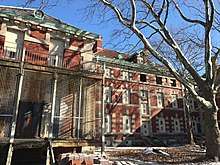
The main building of the general hospital originally consisted of 120 beds and was eventually expanded to three times that size. Original concepts for the hospital included a rooftop bistro style sitting and recreational area. With the Administration Building and Hospital Extension, the general hospital comprised four operating rooms, a women's ward, a pediatric ward, a maternity ward, and a psychiatric ward. It was equipped with two birdcage elevators. Wards were open, and had lots of windows for ventilation and natural light. Each ward was also provided with a south-facing porch for fresh air, and activity. The operating rooms were located on the third floor, and had skylights in order to provide the best lighting possible. Supplemental lighting was provided via I.P. Frink.
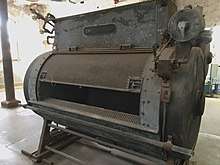
The Hospital Laundry Outbuilding is located adjacent to the Psychopathic Ward, and served the important role of infection control. An industrial laundry, it was equipped with two smith drum machines, an extractor, soap cooker, and a large press called a mangle. It utilized steam from the powerhouse to aid in disinfection. Processing up to 3,000 pieces of laundry per day, the building also had quarters for the laundry staff on the second floor.
The psychopathic ward, built 1906–07, housed thirty beds and was intended for the "temporary treatment" of immigrants suspected of being insane or having mental disorders, pending their deportation, hospitalization, or commitment to sanatoria.[13]
Contagious disease hospital
The contagious disease hospital comprised 17 pavilions, connected with a center structural corridor. Each pavilion contained separate hospital functions that could be sealed off from each other. Utilizing the principles espoused by Florence Nightingale nearly 50 years prior to its design, the hospital is a mature example of the pavilion style of hospital planning. The pavilions include: eight Measles wards, three isolation wards/ staff quarters, a power house/ sterilizer/ autopsy theater & staff quarters, mortuary, laboratory & staff quarters, administration building/ staff quarters, kitchen, & staff house. Capacity was 450 beds. There were four operating rooms and an elevator in the Administration Building.
There were several features in the hospital designed to help contain the diseases. The laundry facility was equipped with a large steam-heated autoclave to sanitize mattresses.[16] In Tuberculosis Wards, each patient room had two sinks. The higher sink was used for spitting and the lower sink was for washing.[17]
The autopsy amphitheater which contained an eight-cadaver refrigerator, became a well-known teaching hall, drawing medical observers from teaching hospitals in the United States and Europe. Eventually, the hospital boasted 28 wards, including separate wards for men, women, children, surgery patients, and the insane.[13]
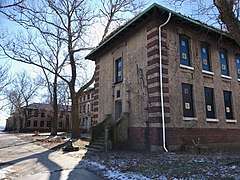 Exterior of the contagious disease hospital
Exterior of the contagious disease hospital An isolation ward[18]
An isolation ward[18]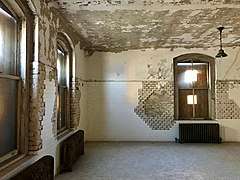 An operating room with white tile walls[19]
An operating room with white tile walls[19] The kitchen inside the staff house[20]
The kitchen inside the staff house[20] A large autoclave to sanitize mattresses[21]
A large autoclave to sanitize mattresses[21] Two sinks in a Tuberculosis ward with the Statue of Liberty reflected in the mirror[17]
Two sinks in a Tuberculosis ward with the Statue of Liberty reflected in the mirror[17]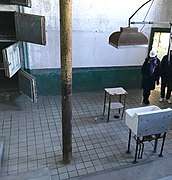 The autopsy amphitheater[22]
The autopsy amphitheater[22]
Unframed
In 2014, the French artist JR installed Unframed, placing large reproductions of photos from when the hospital on interior and exterior walls and windows throughout the structures.[23]
Documentary
Forgotten Ellis Island, a documentary by Lorie Conway, explores the abandoned buildings on the island and covers the history of the hospital. Conway also tracked down immigrants and descendants of immigrants who had spent time in the hospital and discussed their experiences with them. The film premiered on Ellis Island and was later shown on CBS in 2007.[13]
See also
References
- ↑ "Ellis Island - Hudson County, New Jersey". USGS. Retrieved January 1, 2011.
- ↑ http://lcweb2.loc.gov/pnp/habshaer/ny/ny2300/ny2376/data/ny2376data.pdf
- ↑ National Park Service (2009-03-13). "National Register Information System". National Register of Historic Places. National Park Service.
- ↑ "Proclamation 3656 - Adding Ellis Island to the Statue of Liberty National Monument". April 5, 2010.
- ↑ Chan, Sewell (October 26, 2007). "Ellis Island's Forgotten Hospital". New York Times. Retrieved October 2, 2014.
- ↑ "Public gets first look in decades of long-neglected Ellis Island hospital". NJ.com. September 2014. Retrieved October 23, 2017.
- ↑ Heritage, Norway. "OUTBRAKE OF CHOLERA AND QUARANTINE AT NEW YORK HARBOR 1892". www.NorwayHeritage.com. Retrieved October 23, 2017.
- ↑ Chan, Sewell (October 26, 2007). "Ellis Island's Forgotten Hospital". New York Times. Retrieved October 1, 2014.
- ↑ Chan, Sewell. "Ellis Island's Forgotten Hospital". New York Times. Retrieved October 1, 2014.
- ↑ Conway, Lorie. "Forgotten Ellis Island, PBS Films". Missing or empty
|url=(help);|access-date=requires|url=(help) - ↑ Huxtable, Ada (December 9, 1999). "Ghosts of Hope and Despair". Wall Street Journal. Retrieved October 1, 2014.
- ↑ Stakely, Tracy (May 2003). Cultural Landscape Report for Ellis Island (PDF). Olmsted Center for Landscape Preservation. p. 73. Retrieved 21 January 2018.
- 1 2 3 4 Conway, Lorie. "Forgotten Ellis Island". PBS Films. Missing or empty
|url=(help);|access-date=requires|url=(help) - ↑ "Unframed-An Exhibit by Street Artist JR at Abandoned Ellis Island Hospitals". Untapped Cities. Retrieved 21 January 2018.
- ↑ "Ellis Island Today". Save Ellis Island. Retrieved 21 January 2018.
- ↑ Halbfinger, David M. (16 June 1997). "Trying to Save Ellis Island, The Neglected 'Sad Side'". New York Times. Retrieved 21 January 2018.
- 1 2 "Capturing the 'Dark Side' of Ellis Island". NPR. 9 December 2006. Retrieved 21 January 2018.
- ↑ "Ellis Island's South Side". National Park Service. Retrieved 21 January 2018.
- ↑ "Before Ebola, Ellis Island's terrifying medical inspections". PBS News Hour. 15 October 2014. Retrieved 21 January 2018.
- ↑ "First Floor Plan - Ellis Island, Contagious Disease Hospital Staff House, New York Harbor, New York County, NY". Library of Congress. Retrieved 21 January 2018.
- ↑ "Geometries — Ellis Island Autoclave". New York Times. Retrieved 21 January 2018.
- ↑ "Exploring Abandoned Ellis Island – And How It Can Be Saved". Scouting NY. Retrieved 21 January 2018.
- ↑ Save Ellis Island
Further reading
- Cannato, Vincent J., American passage : the history of Ellis Island, New York : Harper, 2009. ISBN 978-0-06-074273-7
- Conway, Lorie, Forgotten Ellis Island : the extraordinary story of America’s immigrant hospital, New York : Smithsonian Books : Collins, 2007. ISBN 978-0-06-124196-3
- Ellis Island Historic District
- Ellis Island Opens